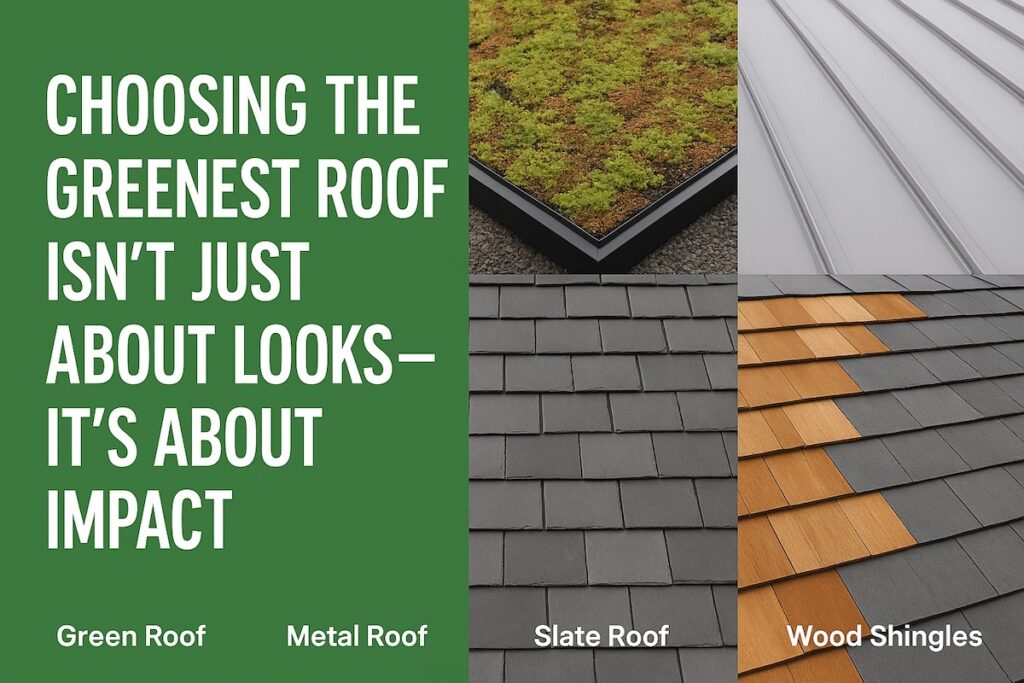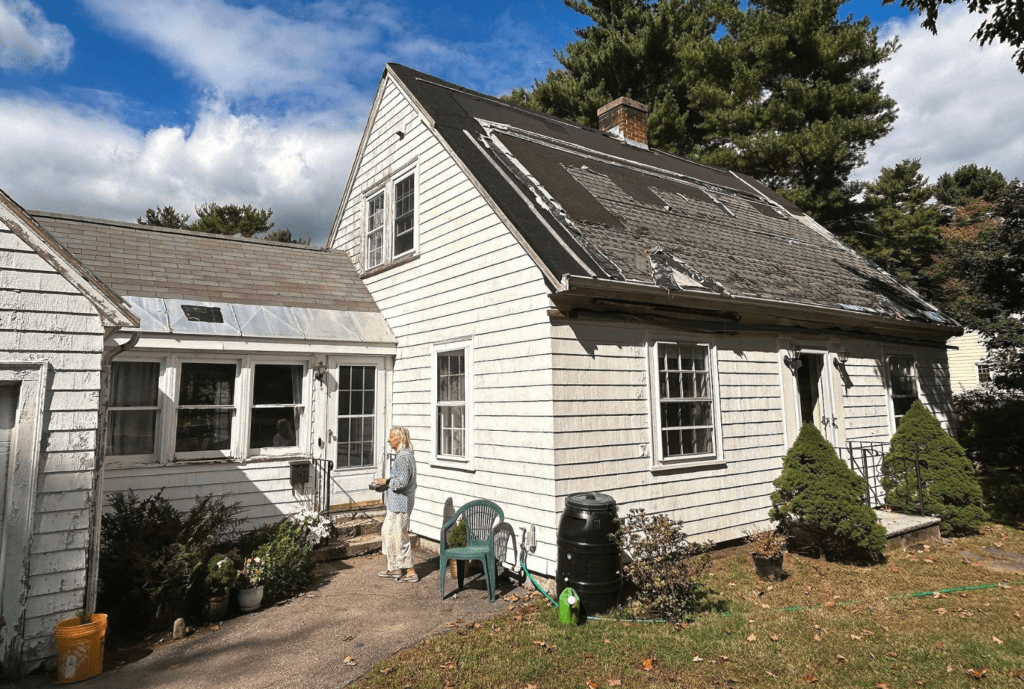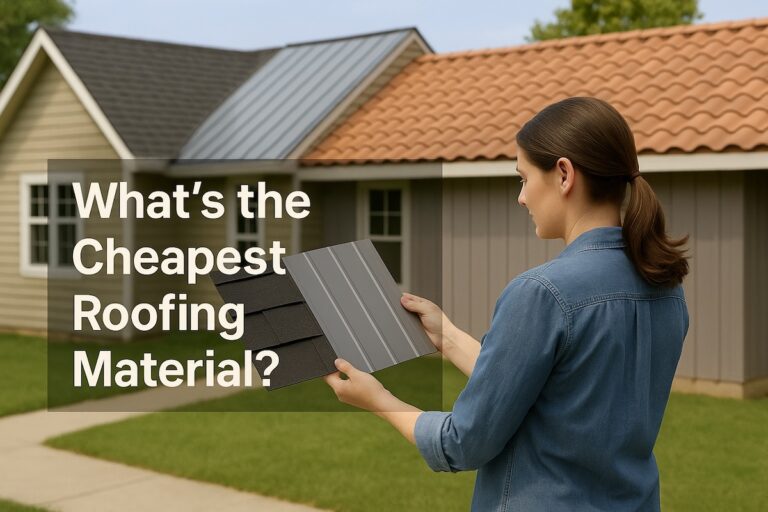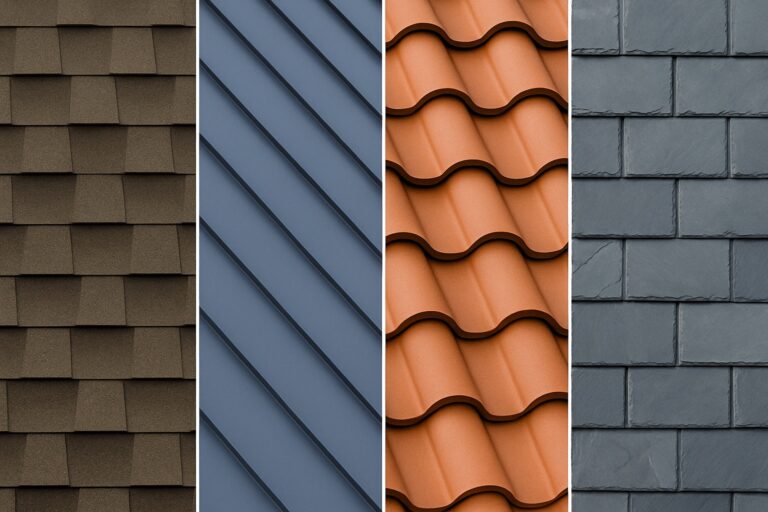Looking for the most environmentally friendly roof? Here’s what actually matters—and which materials live up to the hype:
Metal roofs are the top pick for sustainability—high recycled content, long lifespan, and fully recyclable.
Slate roofing is the original eco-friendly option, lasting over 100 years with minimal processing.
Cool roofs reflect sunlight, lowering cooling costs by up to 30% and reducing urban heat island effects.
Green roofs (vegetative systems) offer insulation, water management, and urban biodiversity benefits.
Wood shingles can be sustainable if sourced responsibly, but they require careful fire and moisture treatment.
Asphalt shingles are the least green—but some newer versions use recycled materials and offer cool roof features.
Insulation and ventilation upgrades during re-roofing can significantly boost energy efficiency—don’t overlook them.
Want to see how each option would look on your home? Try our [Roof Designer Tool] to explore eco-friendly roof styles and colors that suit your space.
Introduction
Choosing the Greenest Roof Isn’t Just About Looks—It’s About Impact
When you hear green roof, it’s easy to picture vegetation growing on a rooftop. But in roofing, “green” goes way beyond that. True environmentally friendly roofing considers the full roof system—from raw roof materials to energy efficiency, lifespan, and end-of-life recyclability.
If you’re searching for a sustainable upgrade, this guide walks you through the real contenders—metal roofs, slate roofs, wood shingles, asphalt shingles, and even cool roof options. We’ll help you understand how your roofing choice affects not just your utility bills, but also the planet.
Whether you’re fighting the urban heat island effect or aiming to use renewable resources, knowing which materials last longer, insulate better, and recycle easier can make all the difference.
Let’s break down the most sustainable roofing options—and help you choose the greenest roof for your home.

What “Green” Actually Means in Roofing (Spoiler: It’s Complicated)
First off, a green roof isn’t just slapping some plants up there (though vegetation-based green roofs are definitely a thing we’ll talk about). When we’re talking about the “greenest roofing,” we’re looking at:
- The raw materials and their source
- Energy used during manufacturing
- How long the damn thing lasts
- What happens when it’s toast
- How it affects your home’s energy use
I once had a client proudly tell me they chose “eco-friendly” asphalt shingles because the brochure said so. After digging deeper, turned out the only “green” thing was a recycled cardboard box they came in. Yikes.
The Material Showdown: What’s Actually Green?
Let’s break down the major players:
Metal Roofing: The Sustainability Heavyweight
Metal roofs are killing it in the sustainability department. The average metal roof contains 25-95% recycled content and is 100% recyclable at the end of its life. I put a standing seam metal roof on my own house five years ago, and while it wasn’t cheap upfront, here’s why it’s my top recommendation:
- Lasts 40-70 years (compared to 15-20 for standard asphalt)
- Reflects heat rather than absorbing it (mine lowered my summer cooling bills by about 20%)
- Crazy durable – the hail storm that destroyed my neighbor’s asphalt shingles just left a couple of dings in mine
- Can be installed right over existing shingles in many cases, keeping waste out of landfills
The downside? Cost. You’ll shell out 2-3 times what you’d pay for asphalt shingles. Worth it over time? Absolutely. Affordable for everyone right now? Nope.
Slate Roofing: The OG Green Material
Before “sustainable” became a buzzword, slate roofs were quietly outlasting generations. Real slate is literally stone cut from the earth, and it:
- Lasts 75-200 years (not a typo!)
- Requires minimal processing (less embodied energy)
- Creates virtually no waste when removed (it’s still stone)
- Provides excellent natural insulation
I worked with a historical restoration company that salvaged 120-year-old slate from a demolition and reinstalled it on another building. Try doing THAT with asphalt shingles!
The catch? Weight and cost. Your house might need structural reinforcement to handle slate, and it’s among the priciest roof materials available. But talk about longevity – one slate roof will outlast 3-4 metal roofs and 8-10 asphalt shingle roofs.
Asphalt Shingles: Can They Ever Be Green?
Let’s be real – traditional asphalt shingles aren’t winning any environmental awards. They’re petroleum-based, rarely recycled, and hit the landfill every couple decades.
BUT – and this is important – innovations in cool roof technology are making some asphalt shingles less terrible. Look for:
- SRI-rated cool roof asphalt shingles that reflect sunlight
- Products containing recycled materials (some use recycled post-consumer waste)
- Manufacturers with shingle recycling programs
I recently spec’d GAF’s Timberline CS shingles for a client – they include recycled materials and offer better reflectivity than traditional asphalt. Not perfect, but better than the standard stuff.
Wood Shingles: Natural But Complicated
Wood shingles look gorgeous and are made from a renewable resource, but the environmental equation isn’t simple:
- Harvesting and processing impacts
- Chemical treatments for fire resistance and rot prevention
- Shorter lifespan than other premium materials
If you’re going this route, cedar or redwood from FSC-certified forests is your greenest bet.
Clay Tiles: Desert-Friendly Option
Clay tile roofs make a ton of sense in hot, dry climates:
- Natural materials with low environmental impact
- Exceptional durability (50-100 years)
- Superior at reflecting heat (a natural cool roof)
I’ve worked with clients in the Southwest who cut cooling costs by 20-30% after switching from asphalt to clay tiles. They’re heavy though, so structural considerations apply.
The Literal Green Roof: Vegetation-Based Systems
Yeah, we need to talk about actual green roofs with plants growing on them. These systems:
- Reduce urban heat island effects dramatically
- Manage rainwater runoff (absorbing 50-90% of precipitation)
- Provide excellent insulation
- Create habitat for wildlife
- Look freaking cool
I consulted on a residential green roof project in Portland where they’re harvesting edible plants from their roof garden. Talk about local food!
The challenges? Weight, complexity, maintenance, and finding qualified installers. This isn’t DIY territory for most homeowners.
Cool Roofs: The Game-Changer for Energy Efficiency
The concept of cool roofs deserves special attention. Any roof material can be more environmentally friendly if it reflects rather than absorbs heat.
A cool roof system can:
- Reduce cooling costs by 15-30%
- Extend roof lifespan by reducing thermal cycling damage
- Decrease urban heat island effects
- Lower greenhouse gas emissions from energy use
I’ve seen homes in southern climates cut their summer A/C use almost in half after switching to a properly designed cool roof system. That’s serious energy savings.
Look for:
- Metal roofs with reflective coatings
- Special cool roof shingles (even dark colors can be formulated to reflect infrared rays)
- Light-colored concrete or clay tiles
- Membranes with high solar reflectance for low-slope roofs
The Recycling Reality Check
Manufacturers love touting how “recyclable” their products are. But here’s the truth bomb – what matters is whether materials actually GET recycled.
Asphalt shingles technically can be recycled, but most still end up in landfills. Metal, on the other hand, has real value, which means it almost always does get recycled.
When a contractor tells you something is recyclable, ask these questions:
- Is there a local facility that actually accepts this material?
- Does your company participate in a take-back or recycling program?
- Can you document where the old roofing will go?
I’ve caught contractors claiming they’d “recycle” materials when they were headed straight to the dump. Don’t get greenwashed.
Beyond Materials: The Whole-Roof Approach
The greenest roof isn’t just about the outer material – it’s a system. Don’t overlook:
Insulation: The Hidden Energy Hero
The most eco-friendly roof in the world won’t matter much if heat pours through poor insulation. I’ve seen homes with fancy sustainable roofing still wasting energy because they skimped here.
When re-roofing, it’s the perfect time to upgrade your insulation to reduce energy consumption. The attic floor should have minimum R-49 in most climates, but more is often better.
Ventilation: Keeping Things Balanced
Proper roof ventilation:
- Prevents moisture build-up (extending roof life)
- Reduces summer heat gain
- Prevents ice dams in winter
- Improves overall energy efficiency
I’ve seen too many “green” roofs fail prematurely because ventilation was an afterthought.


ROOFING VISUALIZER TOOL
See Your Home with a New Roof in Seconds
Help your homeowners visualize new roofing and colors on their own home with Renoworks’ AI technology in seconds.
- Easy-to-use interface designed for contractors and professionals working with homeowners.
Making the Decision: A Practical Framework
So how do you actually choose? Here’s my framework:
- Set your priorities: Are you most concerned about initial cost, lifetime cost, durability, aesthetics, or environmental impact? Be honest.
- Consider your climate: Metal and cool roofs shine in hot climates. Wood isn’t great in wet areas. Slate can crack in freeze-thaw cycles.
- Evaluate your structure: Can it handle the weight of slate or clay? Will you need reinforcement?
- Calculate true lifetime cost: Divide the total cost (materials + installation) by expected years of service. A $30,000 slate roof that lasts 100 years ($300/year) might be cheaper than a $10,000 asphalt roof lasting 20 years ($500/year).
- Factor in energy savings: A cool metal roof might save $300/year in cooling costs compared to dark asphalt shingles.
- Check for incentives: Many utilities and governments offer rebates for energy-efficient roofing.
Bottom Line: What’s Actually Greenest?
If I had to rank roof materials from greenest to least green (considering full lifecycle impact):
- Reclaimed slate or clay tile (reusing existing materials)
- New slate (natural material, minimal processing, extreme longevity)
- Metal roofing (high recycled content, fully recyclable, excellent longevity)
- Vegetation-based green roof systems (environmental benefits but complex installation)
- Clay tiles (natural materials, good longevity)
- Wood shingles from certified sustainable forests
- Concrete tiles (durable but high embodied energy)
- Cool roof asphalt shingles
- Standard asphalt shingles (sorry, they’re just not great environmentally)
But remember – the specific product matters more than the general category. A poorly made metal roof might be worse than premium asphalt shingles with recycled content.
The Last Word
Listen, I’ve seen too many homeowners drop serious cash on supposedly “green” roofing that either didn’t perform or wasn’t nearly as eco-friendly as advertised. Don’t fall for the marketing hype.
The truly greenest roof is one that:
- Lasts a long time (reducing manufacturing and disposal impacts)
- Improves your home’s energy efficiency
- Uses sustainable or recycled materials
- Actually gets recycled at end-of-life
- Makes sense for your specific situation
Got questions about specific products or your particular roofing situation? Drop ’em in the comments – I’m genuinely curious to hear what you’re considering and why.
And for God’s sake, get multiple quotes and check references before hiring anyone to install your green roof. The best materials in the world won’t perform if they’re installed poorly.
Happy roofing!


ROOFING VISUALIZER TOOL
See Your Home with a New Roof in Seconds
Help your homeowners visualize new roofing and colors on their own home with Renoworks’ AI technology in seconds.
- Easy-to-use interface designed for contractors and professionals working with homeowners.
Related Articles
Continue exploring this topic with these related articles, or read one of our case studies to see how visualization has helped remodelers save time and increase their profits.



